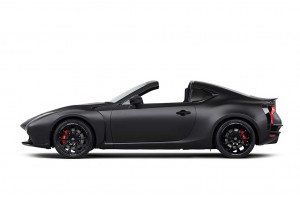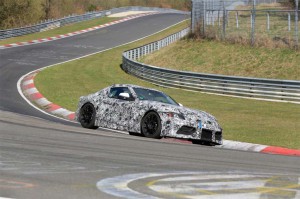Officials with Toyota have confirmed reports that the all-new Supra sports car will ditch the Toyota badge when it goes on sale during the second half of 2019, instead carrying the logo of the Japanese maker’s new sub-brand, Gazoo Racing.
Otherwise known as GR, Gazoo originally was formed to give Toyota a new base in the racing world, and it has been a solid performer, among other things winning the World Rally Championship. But Gazoo is now going to be used as a sub-brand for Toyota’s sportiest models, much like Nissan’s NISMO and BMW’s vaunted M. The first batch of GR models will even include a sportier version of the Prius Prime.
Toyota has made no secret of its plans to bring back the Supra after a long absence, and at an event in Tokyo, GR chief Shigeki Tomoyama told reporters, “the Supra will be by Gazoo.” That appears to also signal that the GR badge will now come to the U.S. market, something the company had so far not been willing to confirm.
(For more on the new GR sub-brand, Click Here.)
As to the Supra itself, the coupe was long the sportiest model in the Toyota line-up, but it ended production in 2002. Rumors of its return have been swirling ever since. What made it likely that the nameplate would return was Toyota’s announcement of a joint venture with BMW in 2012 to come up with a replacement for the Bavarian maker’s aging Z4 model. It was quickly guessed that Toyota’s version would become a reborn Supra.
A concept version of the new BMW Z4 was revealed in August at the 2017 Pebble Beach Concours d’Elegance and rumor has it as many as three versions of the roadster could make it to market.
Unlike an earlier joint venture which resulted in virtually identical sports coupes, the Subaru BRZ and the Toyota 86, BMW and its Japanese partner have ensured major differences in the looks of their two new models, at least based on what we’ve seen to date. For one thing, BMW will deliver a roadster, Toyota a fixed-roof coupe.
Beyond, that, not many details have leaked out about Supra specifics. Tomoya did confirm the new sports car would have a 50:50 weight balance and, hinted that, “hybrid technology will be necessary for the future sports car. It’s not just about prioritizing efficiency, but speed too. The key challenge we need to overcome is controlling the energy flow, the regeneration and keeping the weight low.”
That appears to conflict with some reports about the new BMW Z4 that has suggested there would be no hybrid version – a surprise since the Bavarians are planning a big push into electrification as they begin to pull away from their long dependence on diesel power.
Tomoya also sidestepped questions about why the new Z4 will reach showrooms in 2018 while the Supra will be held for as much as another year.

The GR HV Concept, likely a hybrid version of the 86, made its debut at this year's Tokyo Motor Show.
The recent announcement of the GR sub-brand was itself shrouded in some mystery, Toyota initially appearing to say that the performance badge would be focused on the home Japanese market. When the first seven models were revealed in September the mix included such unlikely performance candidates as the Yaris and Prius Prime, the latter being the plug-in hybrid version of the familiar Toyota Prius.
At the Tokyo Motor Show last month Toyota, meanwhile, unveiled the new GR HV, a hybrid concept that many expect will be the much-desired, performance version of the Toyota 86 coupe.
(For more on the Toyota GR HV Concept, Click Here.)
As with the next-gen BMW Z4, expect to see several powertrain alternatives for the reborn Supra, including a straight-six version targeting classic Supra fans. One other question that lingers is whether all versions will be dubbed GR, or just the top-line performer, much as BMW limits the use of its M badge. On the other hand, the new Supra could become the equivalent of the Mercedes-AMG GT, sold only with the AMG badge but in a variety of different configurations that range from fast to faster to, oh, my lord.
(Click Here for more on the Toyota Fine-Comfort fuel-cell concept.)


